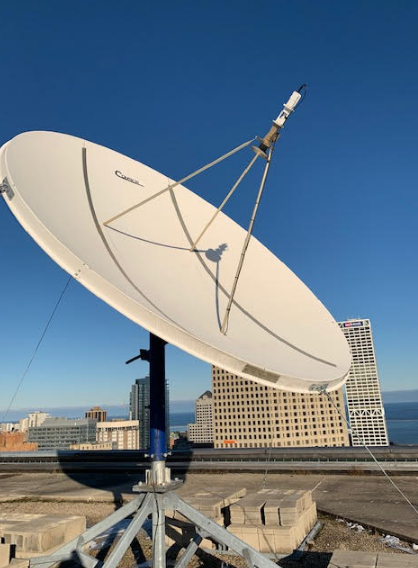The waveguide horn antenna is a widely used important antenna type in microwave and millimeter-wave communications. It combines the advantages of waveguides and horn antennas, transmitting microwave signals through the waveguide and utilizing the horn mouth to achieve signal radiation and reception. The waveguide horn antenna has excellent directionality, high gain, and wide bandwidth characteristics in frequency bands such as the X-band and Ku-band, making it reliable for various applications including satellite communication, 5G millimeter-wave communication, radar systems, and astronomical observations. Its simple structure and mature manufacturing process make it suitable for various environments and demonstrate excellent performance in high-frequency applications.

Basic Concepts
Waveguide horn antennas are well understood for use in microwave and millimeter-wave communications. It is a combination of waveguide and horn antenna, which uses the waveguide to transmit microwave signals outwards but achieves radiation (transmission signal) and reception by utilizing an expanding straw-shaped hole.
The waveguide horn antenna works in the X-band that spans from 8 GHz to 12 GHz commonly applied scenario, with less than 0.1 dB/m transmission loss. As an example, in the Ku-band (12 to 18 GHz), it may have a gain equal to or greater than 20 dBi and cover more than 6 GHz of bandwidth.
The waveguide horn antenna has a simple structure and is mature in manufacturing, those features let it work steadily under various circumstances. For instance, in the field of satellite communication systems deployed on objects orbiting around the Earth, a sound signal transmission is provided by waveguide horn antennas ensuring a very practical way not to allow misalignment error (no more than 1.0 degree due to the use of highly-directional bicone antennas).
Waveguide horn antennas then quickly gain significance as key components for many wireless communication systems exploiting these advantages. In addition to communication, waveguide horn antennas are also used in radar systems and radio astronomy.
Weather radars use C-band waveguide horn antennas, which have a range of up to 100 km and are capable of measuring rainfall levels as low as 1 mm/hour. A waveguide horn used as the feed horn of a satellite dish is an example of which is shown in this picture and has also been mentioned above. These are waveguides that can be circular, square, or rectangular; however, when seen from outside, only their entrance aperture shape will appear (to viewers). Used for receive-only applications such as these, waveguide horn antennas are significant in design.
Development and optimization of waveguide horn antenna design are based on very high computational technology and manufacturing. High-frequency applications benefit from the micron-level precision of 3D printed waveguide horn antennas.

Structure and Principle
A waveguide horn antenna is composed of two parts, waveguides and the mouth. The electromagnetic wave can travel inside the waveguide unchanged because its left and right walls are good conductors or have no material (in an ideal case). In phase plane devices at other frequencies than in the X-band, copper and aluminum are also used for the waveguide. Conductivity provides a guarantee of efficient signal transmission with resistivity as low as 1.68×10^-8 Ω·m.
The horn mouth is an aperture that expands gradually, which makes the electromagnetic wave energy released from free space of breakdown mode, from the guide and forms a directional radiation field. For instance, according to applicable standards for gain horn antennas, the opening angle of the horn mouth is usually between 15 and 30 degrees. The resulting design yields an antenna gain of 20 dBi at a frequency of 10 GHz.
The waveguide horn antenna working operation: the waveguide horn utilizes the structure of a pyramidal (quadrangle geometry) hollow space to guide radiation.
Transmission for waveguide: Transmit microwave signals through the waveguides. Waveguides’ conductive walls are great for corralling electromagnetic waves where they need to go more efficiently than through the wild blue yonder of free space, so signal loss is minimal. Like in S-band waveguide antennas (2 to 4 GHz), the signal loss is usually below 0.2 dB/m for cost-effective penetration of the signals.
Because the mouth part of this kind of horn gradually enlarges in structure, it makes electromagnetic wave energy release here slowly, gradually expanding diffraction to the outside radiation field. This will form a very powerful directivity radiating field when the signal arrives. For instance, a standard gain horn antenna at 5 GHz frequency has a radiation directionality such that the half-power angle (3 dB beamwidth) is approximately 30 degrees, enabling directional signal transmission.
The waveguide is characterized by its dimensions and shape, both of which affect performance. For instance, in the X-band segment, where the WR-90 waveguide is popular, it has a body of 22.86 mm x 10.16 mm dimensions on the inner side of its wall. This size pattern allows for efficient transmission within the range of 8 to 12 GHz.
An equally important aspect is the horn mouth design. A certain duration horn mouth can be used to gradually enlarge and finally convert transverse electromagnetic waves in the waveguide into plane waves traveling in free space. In the K-band, for instance, the horn mouth is dimensioned with a diameter of 15 cm to reach up to a gain of 25 dBi within the 18-26.5 GHz frequency band.
Waveguide Horn Antennas Classification
According to the shape of the horn mouth and the demand for use, waveguide antennas can be classified into different types: rectangular horn antennas, circular horn antennas, and conical horn antennas.
Rectangular Horn Antennas: These types of horns have a rectangular horn mouth and are widely used for high-frequency microwave communications. For instance, in X-band (8 to 12 GHz) applications, rectangular horn antennas are typically made of WR-90 waveguides with inner sizes such as 22.86 mm x 10.16 mm. For Ka-band (26.5 to 40 GHz) applications, WR-28 waveguides with inner dimensions of 7.112 mm x 3.556 mm are specified. The use of a rectangular horn provides high gains (up to 25 dBi), making them ideal for short-range, point-to-point transmissions that require more directional gain than what can be achieved with vertical dipole arrays.
Circular Horn Antennas: These antennas have a circular horn mouth for wideband frequency band applications. At W-band, circular horn antennas work well, and you can expect gains of 30 dBi or higher. In millimeter-wave radar systems, for example, circular horn antennas offer excellent directionality and high gain, making it possible to precisely detect remote targets.
Conical Horn Antennas: These have a conical horn mouth and are used in radars, as well as for astronomical observations. Conical horn antennas often have 15 dBi gain in L-band (1 to 2 GHz) applications. Conical horn antennas are used in ocean monitoring radar systems, for example, where coverage over a wide angle is required but with gain maintained at a sufficient level to adequately monitor variations within the marine environment.
According to the application demand, waveguide horn antennas can also be subdivided into standard gain horn antennas, dual-polarized horn antennas, and high-power horn antennas.
Standard Gain Horn Antennas: This type of antenna is created to produce balanced gain (regularized) and wide bandwidth properties. Conversely, an average gain horn antenna at 5 GHz frequency may well possess a gain of around 15 dBi and offer protection for more than 200 MHz bandwidth. These antennas are utilized in wireless communication methods, including radars.
Dual-Polarized Horn Antennas: These antennas can sustain horizontal and vertical polarizations simultaneously, making them valuable for dual-polarization reception applications. An example application of dual-polarized horn antennas is an advanced weather radar system, which needs to measure precipitation with an accuracy in the order of mm/hour.
High-Power Horn Antennas: These antennas are designed to handle high-power signals and are typically used in military and scientific research fields. In applications such as high-power microwave transmission experiments, input power levels between several tens and hundreds of watts are common requirements to generate capabilities beyond conventional antenna performance (in particular beam directivity) under high vacuum in radiation hazardous environments or even attenuated/lossy media to meet minimum signal delivery.

Uses of Waveguide Horn Antennas
Due to their high performance, waveguide horn antennas are used widely in different areas such as radar systems, wireless communication, and astronomical observation.
Waveguide horn antennas are usually used as transmit/receive (TX/RX) specific radiation systems in radar systems. For instance, C-band waveguide horn antennas can be used in weather radars to detect rainfall at 100 km with a measurement accuracy of 1 mm/hour. Aviation radars use short-range X-band waveguide horn antennas (8-12 GHz) at a gain of 30 dBi or more to precisely detect targets up to 200 km wide.
Wireless communication is facilitated with the help of waveguide horn antennas, playing a vital role in determining reliability and effectiveness during communication. For example, in 5G millimeter-wave communication, waveguide horn antennas can be used for 28 GHz-band high-gain 20 dBi antenna processing and achieving good signal coverage to ensure transmission rates. These will offer far faster transfer speeds, as much as 1 Gbps, from up to a distance of about 2 km in typical urban settings, thereby considerably improving communication efficiency.
Waveguide horn antennas are used in satellite communication systems to ensure reliable transmission of signals. Ka-band waveguide horn antennas, for example, are used in geostationary satellite systems with a frequency range of 26.5 to 40 GHz and can have up to a gain of about 30 dBi. This level of signal transmission accuracy effectively communicates over distances greater than approximately 35,000 km with alignment errors in the range of less than 0.1 degrees, maintaining a high-quality communication link.
They are used in astronomical observations for recording weak microwave signals from the sky and assisting researchers in their work. In the Atacama Large Millimeter/submillimeter Array (ALMA), for instance, waveguide horn antennas can pick up signals from galaxies millions of light-years distant with sensitivity down to the microwatt range. These antennas, operating at the 230 GHz millimeter-wave band, provide gains up to 45 dBi for an unprecedented level of precision in observations.
Waveguide horn antennas are employed in precision surface monitoringfor Earth science and remote sensing applications. For example, in Synthetic Aperture Radar (SAR) systems, L-band (1 to 2 GHz) waveguide horn antennas provide up to 15 dBi of gain with spatial resolution as fine as three meters. These antennas are used for monitoring surface deformation associated with earthquakes, floods, and other natural disasters.






